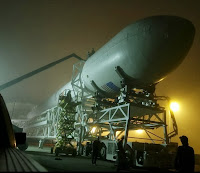 |
| Falcon 9v1.1 Roll out. |
SpaceX has conducted their
first hot fire test of the Falcon 9v1.1 a.k.a Falcon 9 Reusable (F9-R). During a
hot fire or static fire test all crucial systems are enabled and the rocket is fully
fueled and fully prepared for launch, sort of a dress rehearsal if you will. Engines
are fired and throttled to full power for a few seconds before an abort command
is issued to shut them down. All this while the rocket remains firmly bolted to
the pad. By doing this, engineers can collect performance data on all the
rockets vital systems to determine whether or not the rocket is ready for its
mission. This is all in preparation for the launch of the CASSIOPE satellite,
the first passenger to ride the F9-R to orbit. The launch which was scheduled
for September 15th has slipped unfortunately and SpaceX has yet to
confirm a new launch date.
 |
| Business end of the F9-R |
The F9-R sports a stretched
first stage that will eventually become the core stage of the Falcon Heavy and
as the name suggests, is the first steps towards creating a fully reusable
rocket. Future incarnations of the F9-R will sport landing legs and will have
the ability to return safely to earth after each launch. SpaceX is already hard at work on this endeavor. The first stage is powered by 9 upgraded merlin 1D
engines arranged in an octagonal pattern (octaweb) with a single centrally
mounted engine. The Merlin 1D engines are a significant step above the older
Merlin 1C. Not only are they more powerful providing 147,000 lbf when compared
to 94,000 lbf of the 1C, the Merlin 1D also has the highest thrust to weight
ratio ever achieved by a rocket engine. The manufacturing process has also been
optimized meaning lower manufacturing costs in the long run. The first flight
of F9-R will also see the introduction of a payload fairing. A payload fairing
is simply a shell made of composite materials that protect payloads whether it
be a satellite or a space probe during the accent through the densest part of
the earth’s atmosphere after which the fairing is jettisoned so that the
payload can be released into orbit. Since all previous launches took the Dragon
capsule to orbit, no fairing was needed. A fairing however will be crucial as
it is needed to protect the delicate instruments on the CASSIOPE satellite
during the climb to orbit.
SpaceX has a lot riding on
the F9-R as this may be potentially the most challenging launch in the company’s
history. The F9-R incorporates the most technological changes since the
introduction of the block 1 Falcon 9 back in 2010. When you have so many new
modifications all debuting at the same time, the risk of failure is
significantly higher! However the Falcon 9 has proven itself to be a very reliable
booster thus far, even surviving an engine failure at launch during the CRS-1
ISS resupply mission. Falcon 9 is designed to make it to orbit even after losing
two of its 9 Merlin engines, thankfully it hasn’t had to make use of that
feature. Let’s hope it never has to.

 Posted by Unknown
in
Posted by Unknown
in 
0 comments:
Post a Comment